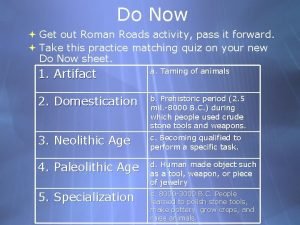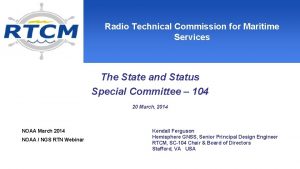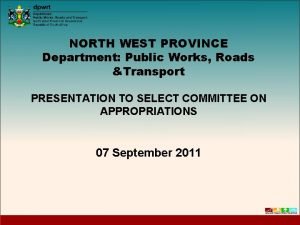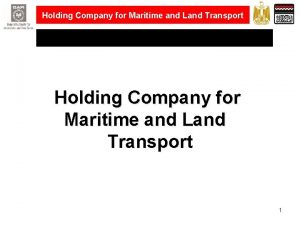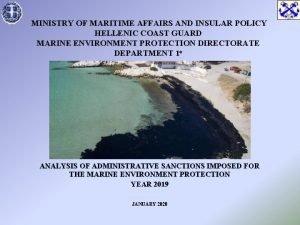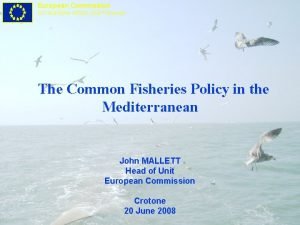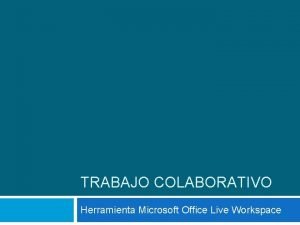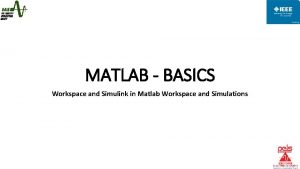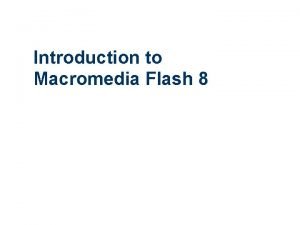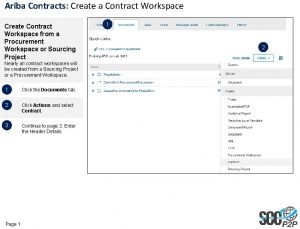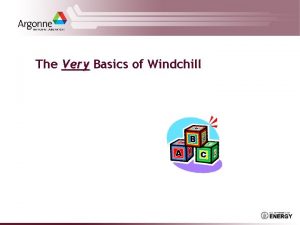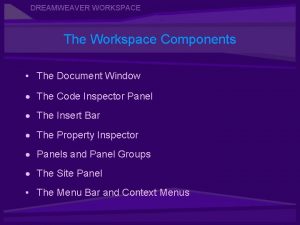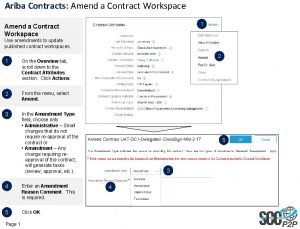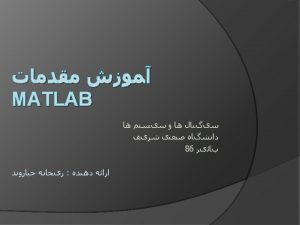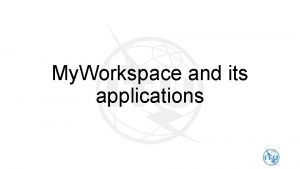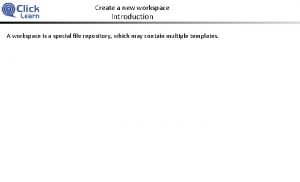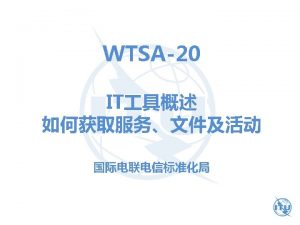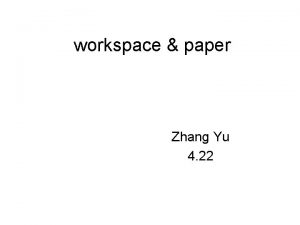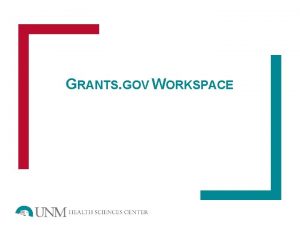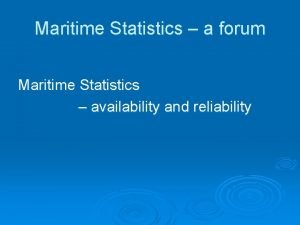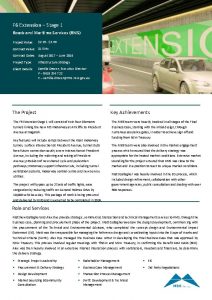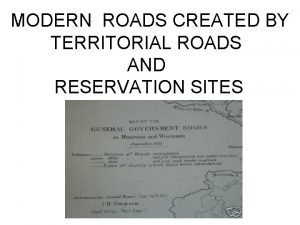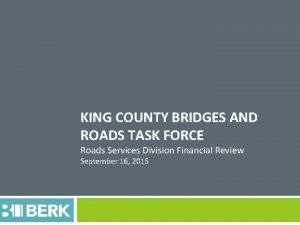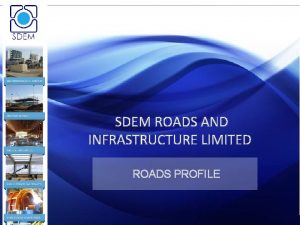Roads and Maritime Services MX Open Roads workspace



























- Slides: 27

Roads and Maritime Services MX Open. Roads workspace Ian Urban CADD Analyst Road Design Engineering Roads and Maritime Services New South Wales

Outline • • Introduction What you get Folder structure Details. 2

Introduction • • Starter pack More elements will be added Has had input from industry Will have to be reconfigured for Open. Roads Designer. 3

What you get • • • Civil cells Design standards for horizontal and vertical alignments Superelevation standards Widening standards Feature definitions Element Templates Project settings for corridor design stages Corridor Templates Terrain display Terrain filters 4

What you get • Working cross section layout configuration • Roads and Maritime Services SUDA feature definitions • Australian pit and pipe data • Custom reports. 5

Folder structure • Most of the resource files - under “RMS-Civil-2017 Project” • All of the configuration - contained in “RMS-Civil 2017. pcf” 6

The details – civil cells • Example Bentley • Roads and Maritime Services ones are: – AUL series – BAR series – CHL series – CHR series. 7

The details – design standards • Based on Roads and Maritime standards • Horizontal and vertical. 8

The details – superelevation • Superelevation supplied is Austroads 8 th Edition 2003. 9

The details – widening • Based on Aust. Roads ARDG 03 -16 which is the same as in RMS Supplement to Austroads • Vehicles catered for: – 12. 5 m Single Unit truck – 19 m Semi Trailer – 25 m B Double – 36. 2 m A Double • 1, 2, 3 and 4 lanes • ARDG 03 -16 Spreadsheet provided • If widening applied where turning path required a 3 m widening is applied. 10

The details – feature definitions RMS-3 D-Linear • For creating features that have a 3 D line style, such as wire rope and W-Beam. 11

The details – feature definitions RMS-Components. • Components are the solid objects that are part of your templates, i. e. the bit that gets extruded • Will look at in more detail when discussing templates. 12

The details – feature definitions RMS-MXRoad: • Created from RMS-MXRoad style set • Maps properties of MX strings to and from Open. Roads • Has been categorised to enable easier navigation. 13

The details – feature definitions RMS-Terrain Display • Definitions for the display of terrains • Controls display of: – Break lines – Boundaries – Imported contours – Islands – Holes – Voids – Spots – Triangles • Display configuration is done in element templates. 14

The details – project settings Project settings: • Control how corridors and linear templates are displayed • Used to decrease the template drop interval • Also used by surveyors for: – Survey settings for a project – For example, linking codes and adjustment defaults. 15

The details – terrain filters • Used for grouping data in an Open. Roads design • Must be 3 D • Can be filtered by feature or symbology • Uses are for grouping: – Surface features to send to MX – Sub-grade features – Pavement features – Barrier strings • Features can be selected by defining a number of attributes, such as: – Level – Element type – Civil features etc. 16

The details – template library Introduction and configuration: • • • Every job is different Point feature – is a string in cross section Point and component naming Linking point names to MX string names Moving towards a unified naming convention suitable for all stages of a BIM project. 17

The details – template library What is in the library: • • Barriers Channels Interfaces Kerb and gutter Pavement types Verges and batters Example templates. 18

The details – template library Pavement types: • Pavement components – Type F (Flexible) F 1 to F 10 – Type B (Bridge) B 1 to B 3 – Type R (Rigid) R 1 to R 6 • Base pavement components folder • Subgrade strings added to RMS-MXRoad style set. 19

The details – cross sections • Cross section creation and drawing is controlled by using a series of preferences • To create the sections use the “RMS-Sheet-Stacked-5 -per-Row”. 20

The details – cross section • • • Use “Annotate Cross Sections” Tool Annotation on the cross sections at a scale of 1: 500 Apply the preferences one at a time Ensure cross section model is correct Ensure that the correct surface is used. 21

The details – data for SUDA • Inlet Pits, headwalls and energy dissipaters have been modelled in 3 D • Contained in “RMS Subsurface Utilities Cells. cel” • Pits have three parts. 22

The details – data for SUDA • Headwalls - created for 1, 2, 3, 4 and 5 cells • Energy dissipaters - created for type 2 and 3, up to a 1050 mm pipe. 23

The details – data for SUDA • Hydraulic inlet data - supplied for all pit types • Australian pipe data - “Concrete Pipe Classes. xml” • AR&R 1987 storm data - “Australian Rainfall and Runoff 1987. xml”. 24

The details – reports • Open. Roads reports are available for: – Geometric – Corridors – Components – Milling – Superelevation – Terrains. • Custom reports for: – Horizontal alignment table – HALGN, VALGN and VERAT reports for MX input – GENIO files from Open. Roads to MX. 25

Questions? 26

MX Final Version? ? 08. 11. 09. 999 FINI 27
 Modern roads vs roman roads venn diagram
Modern roads vs roman roads venn diagram Open source workspace
Open source workspace 영국 beis
영국 beis Sea eight maritime services
Sea eight maritime services Radio technical commission for maritime services
Radio technical commission for maritime services Vodafone cloud services hosting
Vodafone cloud services hosting North west department of public works and roads vacancies
North west department of public works and roads vacancies How did land grants and new roads affect brazil?
How did land grants and new roads affect brazil? How were maritime and land based empires similar
How were maritime and land based empires similar Holding company for maritime and land transport
Holding company for maritime and land transport Ministry of maritime affairs and insular policy
Ministry of maritime affairs and insular policy Dg maritime affairs and fisheries
Dg maritime affairs and fisheries Translation workspace word client
Translation workspace word client Office live workspace
Office live workspace Eduroam uu inloggen
Eduroam uu inloggen Perforce jam
Perforce jam Simulink to workspace
Simulink to workspace Cisco commerce workspace
Cisco commerce workspace Shape tweening in macromedia flash 8
Shape tweening in macromedia flash 8 Contract workspace in ariba
Contract workspace in ariba Translation workspace tutorial
Translation workspace tutorial Windchill commonspace
Windchill commonspace Refinitv workspace
Refinitv workspace Parts of photoshop workspace
Parts of photoshop workspace Dreamweaver document window
Dreamweaver document window Contract workspace
Contract workspace Oracle workspace manager
Oracle workspace manager Clear command window - matlab
Clear command window - matlab
